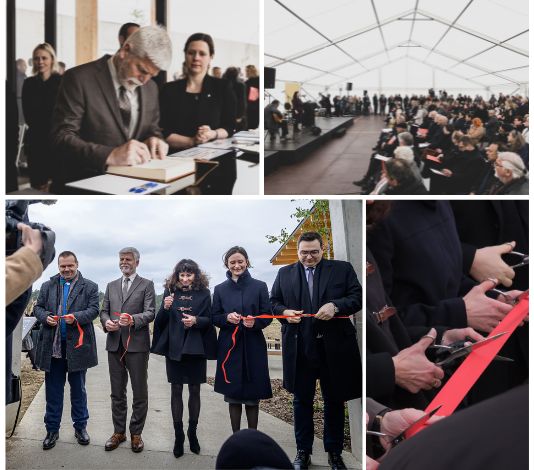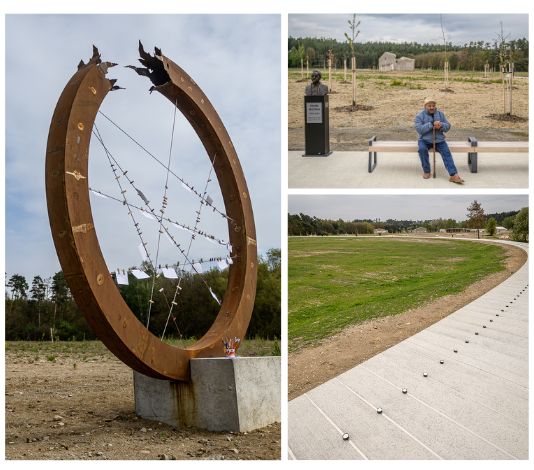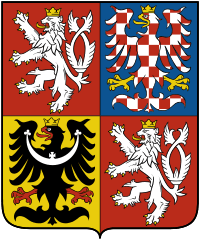Holocaust Memorial in Lety u Písku - memory and hope

Published
The Museum of Romani Culture has opened a memorial to the Holocaust of the Roma and Sinti in Lety u Písku. This rare moment of historical recognition is the result of support from the EEA and Norway Grants. It is an expression of respect for the past and at the same time brings hope for the future. The opening of this memorial represents a major step towards recognising and commemorating the history of the Roma and Sinti communities, while shedding light on the dark chapters of the history.
""The Holocaust Memorial will become an important place for sharing knowledge and understanding of the history of the Roma and Sinti in the Czech Republic and their current situation in the Czech Republic. I am grateful that the EEA and Norway Grants support this important project."
Maria Varteressian - deputy minister, Norwegian Ministry of Foreign Affaires

The memorial in Lety on the day of its inauguration - 23 April 2023
Journey through history
The memorial in Lety u Písku, officially opened to the public in May 2024, responds to a long-standing call for recognition and respect.
It is located on the site of the original "gypsy camp", which was operated between 1942 and 1943. This site witnessed the suffering of many Roma and Sinti families under inhumane conditions, many of whom were later deported to Auschwitz.
The subsequent construction of a pig farm on the site in the 1970s and its operation until 2018 served as a painful reminder of the lack of respect for the memory of the victims. The state's decision to demolish the pig farm and build a memorial to be administered by the Museum of Romani Culture represented a key step towards recognition and dignified remembrance.

Top image: historical picture of the camp, bottom image: the remains of the buildings preserved as part of the memorial source: the Museum of Romani Culture
This new space serves not only to commemorate the Roma and Sinti, but also to provide an educational journey through the authentic memories of witnesses preserved in the "Memory Trail". The implementation of the project that gave birth to the new memorial culminated in the opening ceremony on 23 April 2024, which was attended by descendants of survivors, donors and key figures from the cultural and political environment.
""This site will remind us of the crimes against humanity that took place here. At the same time, it will be a memento for future generations, so that we never allow such horrors to happen again. It will be a reminder of the need to protect human values at all times and for all without exception".
Petr Pavel - president of the Czech Republic

On 23 April 2024, the Holocaust Memorial in Lety u Písku was inaugurated with the participation of prominent personalities, including the President of the Czech Republic Petr Pavel, Prime Minister Petr Fiala, the Deputy Minister of Foreign Affairs of Norway and others. Photo: Petr Vrabec
Through its efforts, the museum, along with other contributors such as the German Embassy and partners such as the Norwegian Falstad Centre, is bringing to light the stories of more than 1 300 Roma and Sinti who were once imprisoned at the site. Their lives and the tragedy that affected them will be honoured through both indoor and outdoor installations at the memorial.
In the visitor centre of the memorial there is a permanent exhibition, while outside there is the Path of Remembrance, where there are spokes in a circle with the names of the victims. Architect Jan Sulzer explains that the spokes represent almost thirteen hundred names of victims, and every thirty centimetres you will meet one name. The exhibition also includes audio-visual testimonies of witnesses.

The Trail of Memory, on which spokes are placed in a circle with the names of the victims, photo by Petr Vrabec
The memorial at Lety u Písku invites us to reflect on the past and to commit ourselves to a future where discrimination and hatred have no place. It represents a significant step in honouring the memory of the victims and educating future generations about the horrors committed during the Second World War.

Permanent exhibition in the interior, photo by Petr Vrabec
"The Holocaust Memorial will be an important tool for sharing knowledge and understanding the history of the Roma and Sinti in the Czech Republic and their current situation in the Czech Republic."
Jana Horváthová, directress of the Museum of Romani Culture.
Cooperation within the project
The memorial was supported by the EEA and Norway Grants through the Culture Programme, which focuses on revitalising the country's cultural heritage and encouraging cultural and creative projects that promote regional development and social inclusion. The programme places a strong emphasis on the preservation and innovative use of cultural heritage, while promoting contemporary art in various disciplines.
"Working with minority heritage has been a priority throughout the Czech Culture Programme, and this is the main project in which we are working with Romani heritage - which is of course very important."
Vegard Berggård - senior advisor, Riksantikvaren
In addition, the programme uniquely addresses societal challenges, with an emphasis on helping the integration of minorities, such as the Roma community, by combating racism and promoting inclusion through culture. This initiative not only aims to enrich the cultural sphere in the Czech Republic, but also to promote an inclusive and diverse society.
In 2022, representatives of the Museum of Romani Culture visited the Falstad Center in Norway to support cooperation on the Holocaust Memorial project in Lety u Písku. The collaboration and exchange of experiences focused on the development of the entire exhibition of the memorial and the creation of educational programmes that benefited from the knowledge of Falstad's educational approaches and AI technologies used to visualise the historical site.
"This is an important project because building and operating memorials is important. Memorials are important for remembrance, for education, for therapy - but also as a means of connecting the past and the present."
Øyvind Skogvold - Director of the Falstad Centre in Norway
The visit highlighted the value of international partnerships in strengthening memorial projects. This initiative is supported by Iceland, Liechtenstein and Norway through grants from the EEA and Norway Grants, highlighting a collective commitment to historic preservation and education.
Forest as a symbol
Last winter, politicians and community members joined together in a significant act of remembrance and recognition - planting trees at the memorial site. This gesture carries the weight of memory and the promise of growth. Most of the seedlings were generously donated by the Orlik estate of Jan and Karel Schwarzenberg, who also honored the memory of Mr. Karel Schwarzenberg, a long-lasting supporter of the memorial's construction.

Planting trees around the memorial, photo: Embassy of Norway
Jana Horváthová, director of the Museum of Romani Culture, emphasized the importance of this forest as a living monument to the lost Romani communities. The forest represents not only as a symbol of those who were lost, but also as a way of acknowledging a chapter of history that has been neglected for too long.
The memorial opened to the public on May 12, 2024.
| Project name: | Lety u Písku. Memorial to the Holocaust of the Roma and Sinti in Bohemia |
|---|---|
| Project promoter: | Museum of Romani Culture |
| Project partners: | The Falstad Centre (Norway) Lety University of West Bohemia |
| Programme: | Culture |
| Grant: | CZK 39 750 000 |
| Project goal: |
Building of a new memorial to the Holocaust of the Roma and Sinti at Lety, a memorial of international significance that will connect the existing Lety Cultural Heritage Memorial with the site of the former camp and thereby will create a comprehensive concept for the dignified honoring of the Holocaust and its Romani victims. |
Project in Media (Czech language only):

